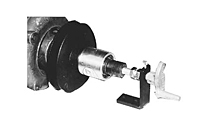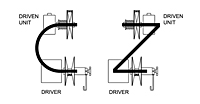- Product Types of LovejoyProduct Types of Lovejoy
- Couplings & Power Transmission Parts CatalogCouplings & Power Transmission Parts Catalog
- Variable Speed DrivesVariable Speed Drives
- Econoline Series Variable Speed DrivesEconoline Series Variable Speed Drives
- Econoline Series MLA Type Manual Pulleys w/o Keyway - ImperialEconoline Series MLA Type Manual Pulleys w/o Keyway - Imperial
- Item Number 68514442591
Item Number 68514442591, Econoline Series MLA Type Manual Pulleys w/o Keyway - Imperial
68514442591Econoline Series MLA Type Manual Pulleys w/o Keyway - ImperialLovejoy
Fixed Center Drives
1/3 Through 5 HP, “A” and “B” Belts
1/3 Through 5 HP, “A” and “B” Belts
-
The Econoline fixed center drive uses a driver pulley that is manually adjustable. (Refer
to the description of Econoline fixed center drives on page VSD-14). There are two types
of controllable pulleys: the M type with a hand wheel and built-in adjusting device, and
the MLA type that uses an external control. The MLA type pulley can be used with the
Lovejoy Model 76 Control Stand or some other type of linear controller.
CJ
CJ
-
Spring-loaded pulleys are through-bored for all types of shaft mounting
arrangements. The exposed spring design allows for a cooler running
pulley and permits easy cleaning. Complete spring enclosures are available
as an option on some models.
-
Econoline pulleys are designed specifically for “A” and “B” section drive
belts, though they can also be used with “4L” and “5L” belts if necessary.
Cogged, raw-edge belts have a definite advantage over wrapped types
because they readily form around small pitch diameters, and provide a
better arc of contact and provide best possible transmission of torque. If
a “slip clutching” effect is desirable to protect machinery in the event of
overload, a wrapped belt is recommended.
-
An adjustable center drive using the Econoline variable speed driver pulley
is an economical, efficient solution for many drive requirements. The typical
adjustable center drive consists of a spring-loaded pulley mounted on
the motor shaft, a companion sheave on the driven shaft, an adjustable
motor base, and a belt. A wide range of sizes and horsepower ratings are
available from the Econoline series to fit the system requirements.
Standard “A” and “B” companion sheaves are recommended for use with Econoline adjustable center drives. Since many Econoline pulleys have only one moveable flange and the companion sheaves are grooved, some misalignment of the belt can be expected and is acceptable for most drives. To minimize this misalignment, the belt should be aligned with the driven sheave when the belt is in the median pitch diameter range of the variable speed pulley, or in the range of principle operation. Due to the minimal bottom contact area of “A” and “B” belts, flat driven sheaves are NOT recommended.
-
Econoline fixed center drives utilize the same type of spring-loaded pulley
as an adjustable center drive, only it is normally mounted on the driven
shaft. The driver pulley is of similar size and construction, but it is manually
adjustable. A fixed center drive offers greater driven speed range in a more
compact space. There are two types of controllable pulleys: the M type with
a hand wheel and built-in adjusting device, and the MLA type that uses an
external control. The MLA type pulley can be used with the Lovejoy #76
Control Stand (see page VSD-21) or some other type of linear controller.
A fixed center drive consists of four component parts: the adjustable driver pulley, the spring-loaded driven pulley, the belt, and a Model 501 Torque Arm Bracket. This bracket prevents the hand wheel from spinning so speed can be changed while the drive is running (see drawing on page VSD-21). The 501 Torque Arm Bracket is NOT needed with the MLA type pulley. A wide variety of drive packages are available from the Econoline Series to suit your needs. Different diameter pulleys can be paired together to achieve a variety of driven speed ranges, and all sizes of driven spring- loaded pulleys are available in a variety of horsepower ratings.
Unit of Measure
Specifications
Description |
N/A MLA-34-1/2-PULLEY-NKW |
Belt Type |
N/A A |
Model |
N/A MLA-34 |
Drive Type |
N/A Fixed Center - Driver |
Weight |
N/A 2.00 lb |
UPC Number |
N/A 42591 |




